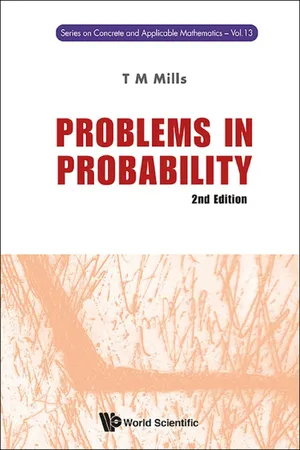
- 192 pages
- English
- ePUB (mobile friendly)
- Available on iOS & Android
Problems in Probability
About this book
This is a book of problems in probability and their solutions. The work has been written for undergraduate students who have a background in calculus and wish to study probability.
Probability theory is a key part of contemporary mathematics. The subject plays a key role in the insurance industry, modelling financial markets, and statistics in general — including all those fields of endeavour to which statistics is applied (e.g. health, physical sciences, engineering, economics, social sciences). Every student majoring in mathematics at university ought to take a course on probability or mathematical statistics. Probability is now a standard part of high school mathematics, and teachers ought to be well versed and confident in the subject. Problem solving is important in mathematics. This book combines problem solving and probability.
Contents:
- Sets, Measure and Probability
- Elementary Probability
- Discrete Random Variables
- Continuous Random Variables
- Limit Theorems
- Random Walks
Readership: Undergraduates and lecturers in probability.
Frequently asked questions
- Essential is ideal for learners and professionals who enjoy exploring a wide range of subjects. Access the Essential Library with 800,000+ trusted titles and best-sellers across business, personal growth, and the humanities. Includes unlimited reading time and Standard Read Aloud voice.
- Complete: Perfect for advanced learners and researchers needing full, unrestricted access. Unlock 1.4M+ books across hundreds of subjects, including academic and specialized titles. The Complete Plan also includes advanced features like Premium Read Aloud and Research Assistant.
Please note we cannot support devices running on iOS 13 and Android 7 or earlier. Learn more about using the app.
Information
PART 1
Problems

Chapter 1
Sets, measure and probability
1.1 Notes
Logic
Sets

Measure and probability











1.2 Problems
According to Rényi [54, p.26] there are 18 different subsets that can be constructed in this way having started with n = 3 distinct subsets A, B, C. Indeed,
Table of contents
- Cover
- HalfTitle
- FrontMatter
- TitlePage
- Copyright
- Dedication
- Preface
- Contents
- Part 1 Problems
- Part 2 Solutions
- Bibliography
- Index